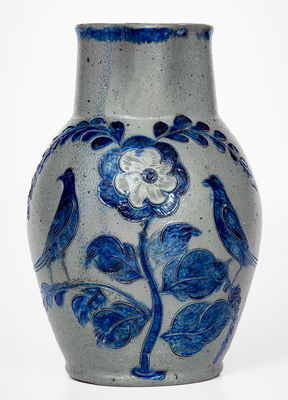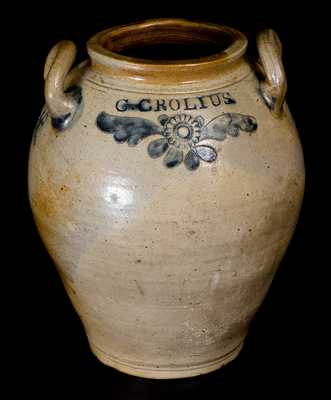Exceedingly Rare and Important Two-Gallon Stoneware Jug with Cobalt Foliate Motif, Inscribed "John Remmey," probably John Remmey II, Manhattan, NY, circa 1785, ovoid jug with footed base and heavy tooling to spout and shoulder, the upper body decorated with a brushed foliate motif and incised with the script signature, "John Remmey." Cobalt highlights to handle terminals. This recently-surfaced work survives as one of only two hand-signed Manhattan stoneware pieces made by a member of the Remmey family. The second is a well-known tea flask made by Henry Remmey, Sr., dated 1789, in the collection of the Smithsonian Institution. A few John Remmeys worked as potters in 18th and 19th century Manhattan. The family patriach, John (Johannes) Remmey I, arrived in Manhattan from Westerwald, Germany in the early 18th century and married into the family of another Westerwald potter, George Corsilius. His son, John Remmey II, would continue the family tradition as a potter in the city, and his grandson, John Remmey III, operated his own pottery along with another grandson, Henry, on Pot Baker's Hill after John Remmey II's death. The style of this jug almost certainly eliminates John Remmey I, who died in 1762, as its maker. The existence of signed documents by John Remmey III indicate he was not the jug's maker either. The probable maker of this work is John Remmey II (1738-1792), as the vessel exhibits an overall style consistent with pieces produced towards the end of Remmey II's lifetime, including a spout construction that began to be used during the late 18th century and would continue to be used for the first two decades of the 19th century. It is this style of spout that is commonly found on the products of Remmey II's son, John Remmey III. Among the most significant discoveries in Manhattan stoneware of the last several years, this jug helps build a body of work for the earliest Remmeys in America, co-founders of this nation's stoneware tradition, and artisans whose documentable work is essentially non-existent. Provenance: A fresh-to-the-market example, acquired by the consignor decades ago. Essentially as-made condition with some in-the-firing flaws, including the following: one side with a glazed-over dent and adjacent in-firing surface chip wiith short lines emanating from it; opposite side with a small, in-the-firing U-shaped line and a small, in-the-firing surface chip with two short lines emanating from it; a shallow in-the-firing contact mark to top of spout. H 13 3/4".




















